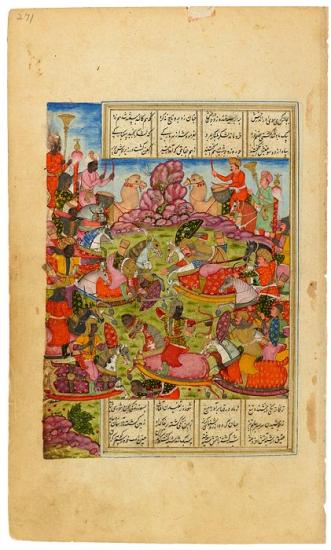Iskandar Battles the Zangīs

Iskandar Battles the Zangīs
Khamsa (Quintet), in Persian, written by Mullā Fatḥ Muḥammad
Purchased by Pierpont Morgan, 1910
The fourth poem in the Persian poet Niẓāmī's Khamsa (Quintet) is the Iskandarnāma (1194), consisting of stories about Iskandar (Alexander the Great). Iskander, the king of Rūm, had sent his messenger/orator Tūtiyā-Nosh to the African king of Zang, who, out of rage, killed the beautiful messenger, decapitated him, and drank his blood. The miniature depicts the defeat of the African army of Zang by Iskandar's army. The drummers for each side are on camels at the top, while the defeat is shown in the middle ground. In the foreground the Zangīs flee. After his return from victory Iskandar laid the foundations of Alexandria.
Persian poetry
The Persians loved their poetry and their poets, though the Qur˒an warned against believing their words (sura 69.41) and "those straying in evil who follow them" (sura 26.224). While Arabic was the first language of Islam and the language of the Qur˒an, Persian was favored by poets. Even Firdausī's (940–1020) celebrated Shāhnāma (Book of Kings), the national epic of Persian, was written in verse—some 50,000 couplets! Rūmī (1207–1273), the best known of the Sufi poets, put poetry in perspective when he wrote, "A hundred thousand books of poetry existed / Before the word of the illiterate [Prophet] they were put to shame!" (Masnavī I, 529). Presented here are illustrations of Firdausī's Shāhnāma as well as works by Sa˓ dī (ca.1184–1292), Hāfiz (ca. 1320–1389), and Jāmī (1414–1492), regarded as the last of the great Sufi poets. Also featured are illustrations from each of the five poems of the Khamsa (Quintet), by Niẓāmī (ca. 1141–1209), especially Lailā and Majnūn (The Persian Romeo and Juliet) and Bahrām Gūr's Seven Princesses.